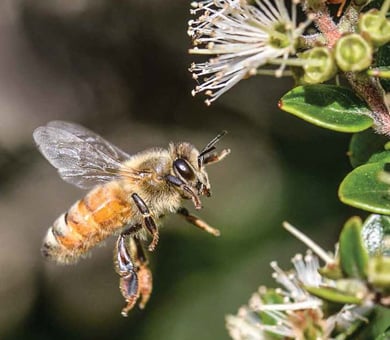Huge increase in demand
In recent years, DOC has seen a significant increase of interest in placing beehives on public conservation land. We recognise the value of honey to the New Zealand economy, and the potential benefit of using public conservation land as a resource. However, our priority is conservation. It's important DOC manages any risks beekeeping presents to conservation, and ensures the beekeeping model is sustainable.
DOC has integrated science into the beehive allocation work. See Honeybees on public conservation lands report (PDF, 316K) which was commissioned to understand the impact of honeybees on native species.
Honeybees compete with native species

Honeybee approaching a white rata
Image: Jeremy Rolfe | DOC
Research shows honeybees, an introduced species, may compete with some native species for food as they forage nectar and pollen from many of the same flowers as native birds, bats, lizards and insects.
They also increase pollination of some weeds and alter pollination processes in some native plants.
There is a risk of spreading pests or diseases from beekeeping on public conservation land.
Mānuka plantations
DOC has assessed the potential of mānuka plantations for ecological restoration, carbon sequestration and revenue on conservation land. There are concerns about the risk of hybridised mānuka on the natural diversity of mānuka species.
Until further research is carried out, planting will only be considered where local seed can be sourced.
Myrtle rust risk
Myrtle rust is a serious fungal disease that affects plants in the myrtle family. It can damage and kill plants such as pōhutukawa, mānuka and rātā. These plants are critical for healthy ecosystems to support our native species such as birds, bats, lizards and insects.
Research from MPI has shown honeybees are a vector for myrtle rust. Honeybees can bring myrtle rust spores into their hives, where the spores remain viable for up to 9 days. There is the risk honeybees, when leaving the hive to forage, can take the myrtle rust spores with them. This increases the risk of spores being spread to the surrounding area, as honeybees can travel up 10 km from their hives.
The majority of beekeeping concessionaires who place their hives on public conservation land bring their hives in from private sites in other parts of New Zealand. There is a risk of hives infected with myrtle rust being brought onto conservation land, and honeybees spreading myrtle rust throughout valuable ecosystems.
DOC is using a precautionary approach to the myrtle rust risk until more information about the role of honeybees in myrtle rust is established. DOC has implemented restrictions on the movement of hives in specific parts of the country, in an effort to reduce the introduction of myrtle rust. The following restrictions apply:
- No beehives from the North Island are to be placed onto public conservation land sites in the South Island.
- No beehives from the Operation Districts of New Plymouth, King Country, Waikato, Hauraki, Tauranga and Auckland are to be placed on public conservation land sites within the Operational Region of Northern North Island.
- No beehives from the Operational Districts of Golden Bay, Motueka, Sounds and Marlborough South are to be placed on public conservation land sites within the rest of the South Island or North Island.
- No beehives from outside the Te Paki Ecological District are to be placed on public conservation land sites within the Te Paki Ecological District.
DOC will undertake an annual review to establish if the restrictions have reduced the spread or introduction of myrtle rust in specific areas of New Zealand. DOC will also continue to work with key stakeholders to better understand the myrtle rust risk from honeybees, and how the risk can be managed. This will impact how DOC continues to manage beehives.
Working with iwi
DOC engages with iwi as our Treaty partners on conservation issues – including beekeeping.
Working with others
We work with Apiculture New Zealand to make sure our processes are well connected with the industry, and beekeepers are kept informed.
We are part of a multi-agency group, facilitated by the Ministry of Primary Industries, looking at mānuka and beekeeping issues to ensure a joined-up government approach.
Beekeeping on public conservation land
If you’d like to put beehives on public conservation land, follow our application guidelines: